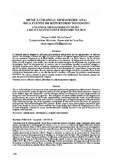| dc.rights.license | http://creativecommons.org/licenses/by-nc-sa/3.0/ve/ | |
| dc.contributor.author | Vargas Cullell, María Clara | |
| dc.date.accessioned | 2016-09-28T15:07:33Z | |
| dc.date.available | 2016-09-28T15:07:33Z | |
| dc.date.issued | 2016 | |
| dc.identifier.issn | 1690-3226 | |
| dc.identifier.uri | http://www.saber.ula.ve/handle/123456789/42398 | |
| dc.description.abstract | La llamada música antigua ha sido parte del repertorio interpretado por las agrupaciones de diversas épocas. Sin embargo, a inicios del siglo XX inicia el interés de algunas grupaciones por especializarse en este repertorio compuesto en la Edad Media, el Renacimiento o la época barroca. En las décadas posteriores, gran cantidad de intérpretes se dedicaron a este repertorio. El surgimiento de ediciones urtext
(fieles al texto original) y facsímiles, la reedición de tratados antiguos de ornamentación, la publicación de múltiples libros de interpretación, la construcción de instrumentos basados en modelos antiguos e infinidad de grabaciones dieron un impulso importante al movimiento. En la búsqueda por la novedad, uno de los aportes importantes de esta tendencia fue el descubrimiento de compositores y repertorio que
habían sido olvidados por siglos. En este contexto, algunos musicólogos volvieron su mirada a los archivos eclesiásticos latinoamericanos, y con ello dan inicio a estudios y ediciones de partituras completamente novedosos. En síntesis, durante la época colonial, la música fue fundamental. Inicialmente, porque fue parte del proceso de adoctrinamiento religioso. | es_VE |
| dc.language.iso | es | es_VE |
| dc.rights | info:eu-repo/semantics/openAccess | |
| dc.subject | Música colonial | es_VE |
| dc.subject | Mesoamérica | es_VE |
| dc.subject | Adoctrinamiento religioso | es_VE |
| dc.title | Música Colonial Mesoamericana: Rica Fuente de Repertorio Novedoso | es_VE |
| dc.title.alternative | Colonial Mesoamerican Music: A Rich and Innovative Rertoire Source | es_VE |
| dc.type | info:eu-repo/semantics/article | |
| dc.description.abstract1 | The so-called old music has been part of the repertoire performed by groups from different eras. However, in the early twentieth century it begins the interest of some groups to specialize in this repertoire composed in the Middle Ages, the Renaissance and the Baroque period. In subsequent decades, large numbers of interpreters were devoted to this repertoire. The emergence of Urtext editions (faithful to the original text)
and facsimiles, the reissue of old treaties ornamentation, publishing numerous books of interpretation,
building on old models based tools and countless recordings gave an important impetus to the movement. In the search for novelty, one of the important contributions of this trend was the discovery of composers and repertoire that had been forgotten for centuries. In this context, some musicologists turned their gaze
to the Latin American church archives, and thus they begin studies and editions of completely new scores. In short, during the colonial era, music was fundamental. Initially, because it was part of the process of religious indoctrination. | es_VE |
| dc.description.colacion | 266-272 | es_VE |
| dc.description.email | maria.vargascullell@gmail.com | es_VE |
| dc.description.frecuencia | Semestral | |
| dc.identifier.eissn | 2244 - 842X | |
| dc.subject.facultad | Núcleo Rafael Rangel (NURR) | es_VE |
| dc.subject.institucion | Universidad de Los Andes | es_VE |
| dc.subject.keywords | Colonial music | es_VE |
| dc.subject.keywords | Mesoamerica | es_VE |
| dc.subject.keywords | Religious indoctrination | es_VE |
| dc.subject.pais | Venezuela | |
| dc.subject.publicacionelectronica | Academia | |
| dc.subject.thematiccategory | Artes y Humanidades | es_VE |
| dc.subject.tipo | Revistas | es_VE |
| dc.type.media | Texto | es_VE |


